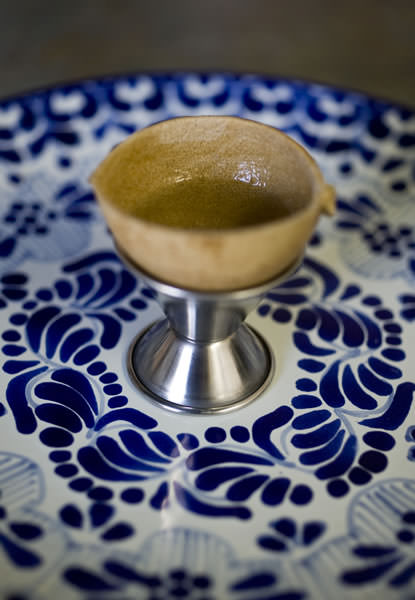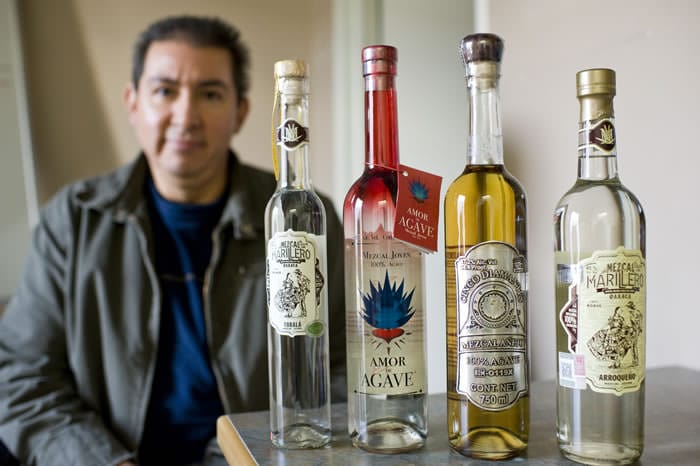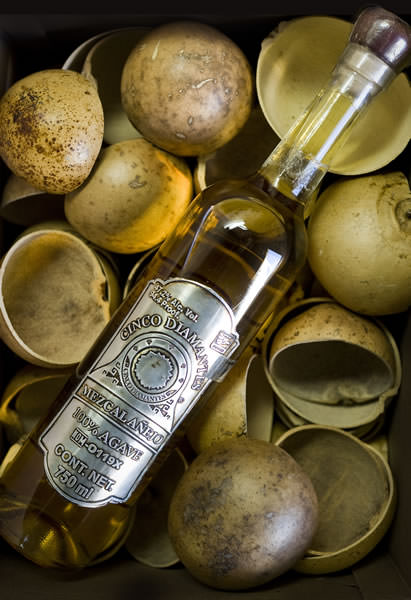good spirits
SMALL BATCH MEZCAL
A nod to tequila’s elder elixir.
WRITTEN BY HEIDI BETHEL
PHOTOS BY CANDICE NYANDO
Twice a year, Eduardo Reyes ventures to Oaxaca, Mexico, in pursuit of purveying the finest mezcals the region has to offer. He works with the individual mezcaleros to import their limited small-batch supplies of the agave-based liquor Reyes touts as “the father of tequila” because of its older, smokier, stronger profile. For two years, Reyes has operated Artisanal Mezcals in Reno, bringing this age-old-yet-newish libation to Nevada.
“You can’t find quality mezcals in Nevada,” he says. “I decided to start importing it because the process it takes to produce this is really an art. It’s traditional and should be appreciated.”
All about agave
There are more than 30 types of agave plants used to make mezcal. Cultivated agave takes eight to 12 years to mature, while its wild counterpart can grow 25 years or more. Michael Moberly, spirits program director at Whispering Vine Wine in Reno, also regards this Latin libation with fondness and has an appreciation for the arduous process involved in turning an agave seedling into bottled perfection.
“Mezcal is a beautiful and imperfect idea that makes spirits great,” Moberly says. “Nature requires you to have patience to enjoy agave. You bake and crush and ferment and distill just for a taste of a new life given to something that is so brilliant in its simplicity.
“Agave wants to be alcohol,” he continues. “It starts to ferment right when you crack it open. Agave is nature’s gift that we, in turn, give new life in the form of mezcal, because one great gift deserves another.”


Regional roots
Just like wine, there are specific areas in Oaxaca, Mexico, that provide distinct flavors to the agave.
“I have my favorites from different microclimates that range in taste and price point. Tobalá tends to be one of the most common, and espadin is the king of agave used in mezcals,” Reyes says.
According to Reyes, mezcal has been popular in Europe for a long time.
“The U.S. is just waking up to the big wave that is mezcal,” he says. “There are a lot of new mezcal bars opening in metropolitan areas. Now, Nevada is getting a taste.”
Speaking of taste … like a fine French Cognac or Scotch whisky, high-end mezcal is meant for sipping. Unlike tequila, there is no need to dampen the flavor with lemon, lime, or salt.
“By nature and in respect to the labor-intensive process, most enjoy mezcal straight,” Reyes says.
He notes that for some of the inexpensive varieties, the traditional accoutrement for mezcal is orange dipped in cinnamon. This enhances the flavor and encourages some of the smoky undertones to come forward. And there are several cocktails that lend well to mezcal’s essence.
Artisanal Mezcals sells directly to the public through Themezcalmarket.com. You also can find its imports behind the bar and on the drink menu at Death & Taxes in Midtown Reno.
Having worked behind the bar serving countless margaritas and Latin-inspired cocktails, Heidi Bethel shares an appreciation for the care and hard work that goes into making each and every bottle of mezcal.
Resources
Mezcal essentials
– There are more than 30 species of agave that mezcaleros use in their proprietary recipes. These agave plants can weigh 88 pounds or more.
– Mezcal gets its smoky flavor from the ardent production process. The hearts of agave plants, called piñas, are cooked for about three days in pit ovens in the ground. The cooked agave is then mashed, combined with water, then fermented for one month or more before it is twice distilled.
– While many believe it originates in tequila, mezcal actually features the infamous agave worm (or gusano) in the bottle. Introduced initially as a marketing ploy, the gusano is the larvae of a moth that lives in agave plants. It has since become less commonplace in mezcals, but some varieties still do include what may be considered a liquor-infused delicacy.
– In Mexico, mezcal is served with worm salt or sal de gusano — a combination of ground, fried larvae, ground chili peppers, and salt.

Mezcal Cocktail
(courtesy of Eduardo Reyes, owner, Artisanal Mezcals in Reno. Serves 1)
2 ounces cranberry juice
2 ounces Mezcal Marillero Arroqueño for smoky flavor OR 2 ounces Young Premium Mezcal Amor de Agave for less smoky flavor
3 – 4 small pieces fresh pineapple, for garnish
Combine ingredients in shaker. Mix thoroughly and pour into short glass filled with ice. Top with pineapple pieces.
Oaxacan State of Mind
(courtesy of Michael Moberly, spirits program director, Whispering Vine Wine in Reno. Serves 1)
2 ounces Mezcal Amarás Espadin
¾ ounce Ransom Sweet Vermouth
½ ounce Amaro Sfumato
Orange twist for garnish
Stir and serve in Champagne coupe with orange twist.
WRITTEN BY BARBARA TWITCHELL
PHOTOS BY JAMIE KINGHAM, JEN BRITTON, AND COURTESY OF CHAD AND ELYSA KLEIDOSTY


